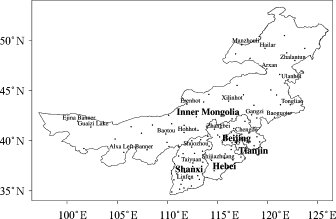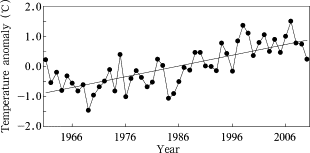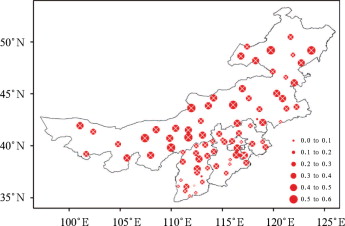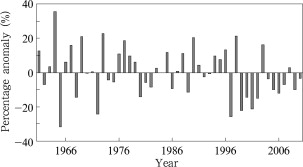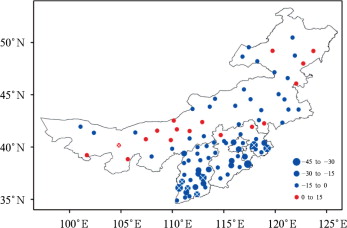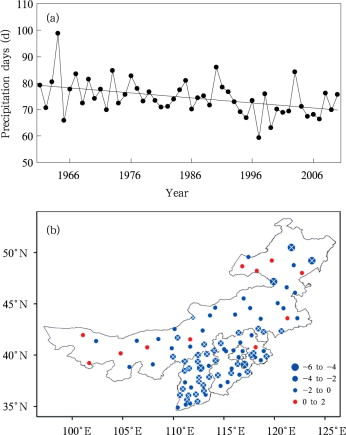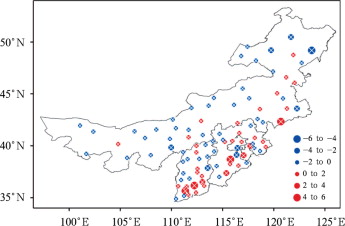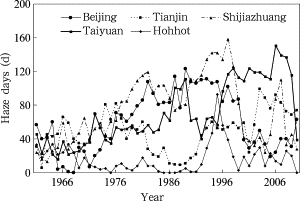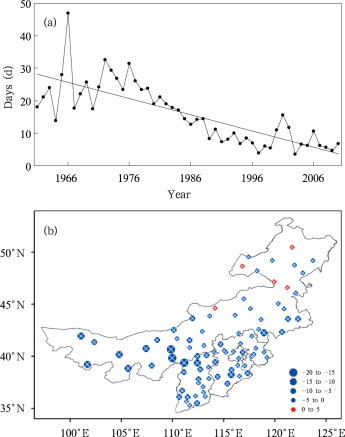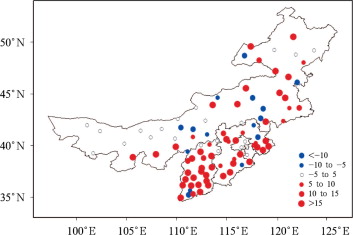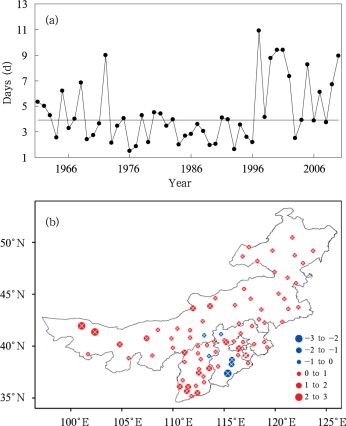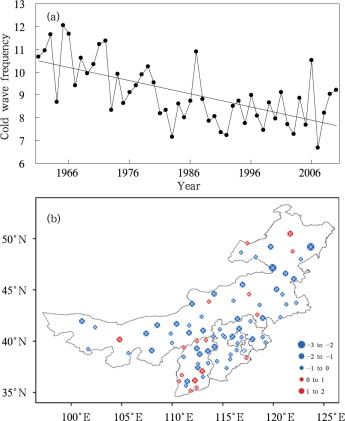Abstract
The spatial and temporal variations of some important near-surface climate parameters and extreme climate events in North China during 1961–2010 are analyzed by using 94 meteorological stations’ data in the study area. Results show that the annual mean surface air temperature in North China increased at the rate of 0.36°C per decade, higher than the national average in the same period. Increasing was particularly significant since the mid-1980s, with maximum increase in the middle and northeastern parts of Inner Mongolia. Increasing rate of the annual mean minimum temperature is much higher than that of the maximum temperature, which results in the decrease of the annual mean diurnal temperature range. Noticeable decrease is also observed in the frequency of cold wave. Annual precipitation shows a slight decreasing trend, with more pronounced decrease in southern Shanxi and eastern Hebei provinces, which is mainly represented as decreasing in contribution rates of rainstorm and heavy storm in flood-season (May to September). During 1961–2010, North China is characterized by a noticeable reduction in annual extreme precipitation, and an increase in high-temperature days over most parts, as well as more frequent droughts. There are remarkable reductions in annual sunshine duration and mean wind speed, associated with the most significant reduction of mean wind speed in midwestern and eastern parts of Inner Mongolia. Meanwhile, North China has experienced a noticeable decrease/increase in annual mean sanddust/haze days during the study period. However, there is no significant trend in fog days, except a pronounced decrease since the 1990s.
Keywords
North China ; temperature ; precipitation ; extreme climate events
1. Introduction
The global mean surface temperature over the past 100 years (1906–2005) has increased by 0.74°C, and the linear warming trend from 1956 to 2005 is nearly twice as that from 1906 to 2005 [ IPCC, 2007 ]. From 1951 to 2009, the warming rate of the averaged land surface air temperature in China is 0.23°C per decade. Since 1951, the frequency and intensity of extreme climate events (e.g., high temperature, low temperature, heavy rainfall, drought, typhoon, dense fog, sanddust) have experienced obvious changes, and with enormous regional differences. Climate change has various impacts on different sub-regions of China, and those sub-regions with vulnerable ecological environment are subject to more notable influence [ ECSCNARCC, 2011 ]. North China is one of the regions with the most stable and significant warming in China [ Ren et al., 2005a ]. In this paper, North China includes Beijing city, Tianjin city, Hebei province, Shanxi province and Inner Mongolia autonomous region, covering the cold temperate, temperate, and warm temperate zones from north to south, and passing through the semi-humid, semi-arid, and arid climate zones in turn from southeast to northwest, resulting in large climate differences. Besides, climate in the study region is subject to wide variations as a result of the influence of the topography, demonstrating significant regional or local features of climate change. North China is rich in resources and has experienced rapid economic development. Moreover, it is one of the most sensitive and vulnerable areas impacted by climate change. Recently, North China has been in the critical period of accelerating regional cooperation, economic development mode transformation and ecological civilization construction. Therefore, it will suffer from a higher disaster risk as a result of climate change [ Shi et al ., 2010 ; ECSCNARCC (Editorial Committee for Second China’s National Assessment Report on Climate Change), 2011 ]. In order to get comprehensive and systematic understanding of the basic facts of climate change over North China in the past few decades, this paper has performed a detailed analysis of temperature, precipitation, mean wind speed, sunshine duration, fog, haze, sanddust weather, and some extreme climate events by using observation data from meteorological stations in the study area during 1961–2010.
2. Data and methods
2.1. Data
The data used in this paper are daily observations from 403 meteorological stations for the period 1961–2010 provided by five provincial (autonomous regional and municipal) Climate Centers in North China. The data homogeneity is influenced by great changes in the observation environment of some stations after relocation. Therefore, the homogeneity test was applied to the temperature data for the correction of nonhomogeneous station data based on standard normal homogeneity test [ Alexandersson, 1986 ; Alexandersson and Moberg, 1997 ] and the two-phase regression test [ Reeves et al., 2007 ]. Based on a comprehensive consideration of factors, such as spatial distribution of stations, and length, integrity and representativeness of the data time series, only data from 94 meteorological stations were chosen for analyzing the basic features of climate change in North China (Fig. 1 ).
|
|
|
Figure 1. Distribution of the 94 meteorological stations over North China used in this paper |
2.2. Methods
Regional averaged time series of the parameters are calculated by the arithmetic mean of all the chosen observation stations in North China. The climate means of 1971–2000 are used in the calculation of anomalies for all the parameters. Seasons are defined as follows: spring (March to May), summer (June to August), autumn (September to November), and winter (last December to February).
High-temperature days are defined as days with daily maximum temperature ≥ 35°C. Precipitation days are defined as days with daily precipitation total (R) ≥ 0.1 mm, which are classified into five grades of intensity: 0.1 mm ≤ R < 10 mm (light rain), 10 mm ≤ R < 25 mm (moderate rain), 25 mm ≤ R < 50 mm (heavy rain), 50 mm ≤ R < 100 mm (rainstorm), and R ≥ 100 mm (heavy storm). The contribution rate of different rainfall grade is the ratio of the sum of rainfall with corresponding intensity to the precipitation total over a period. The percentile threshold method is used to define extreme climate events [ Zhai and Pan, 2003 ; Zhai et al ., 2007 ; Wang et al ., 2012 ]. The amount and frequency of extreme precipitation are defined as the sum of rainfall and number of days, respectively, based on days with precipitation above the 95th percentile of the standard period 1971–2000. The indicators of cold/warm nights are the days with a minimum temperature below/above the 10th/90th percentile. The indicator of cold days is the days with the maximum temperature below the 10th percentile. A fog day is defined as a day when horizontal surface visibility is limited to 1 km or less, which is caused by near surface water vapor cooling down and condensing into fine droplets and suspending in the air. A haze day is a day when a large number of particles suspended in the air, which cannot be distinguished by naked eye, limit the horizontal surface visibility to 10 km or less. This paper, following the definition of Fan et al. [2005] and Wu et al. [2006] , selects the days when visibility is less than 10 km at BTM 14:00 and relative humidity is less than 90%, eliminating situations of vision obstruction, such as precipitation, blowing snow, snow storm, blowing sand, dust storms, floating dust, and smoke screen. Following this, the climate data series of haze days at five typical urban stations (Beijing, Tianjin, Shijiazhuang, Taiyuan, and Hohhot) are constructed. A day with any type of weather phenomena of duststorm, blowing sand or floating dust, is defined as a sanddust day [ Qian et al ., 2002 ; Zhang et al ., 2005 ]. The integrated meteorological drought index (CI index) is used to analyze the drought variations in North China [ Zhang et al., 2006 ].
The magnitude of the climate trends can be represented by the linear trend, and can also be represented by differences between two time periods in the averages [ Zou and Zhang, 2008 ; ECSCNARCC (Editorial Committee for Second China’s National Assessment Report on Climate Change), 2011 ]. The linear trend is tested for significance with the t -test [ Wei, 2007 ].
3. Results
3.1. Temperature
3.1.1. Mean temperature
Figure 2 depicts the annual mean temperature anomalies for North China. Annual mean temperatures of North China show an increase of 1.79°C from 1961 to 2010, with a warming rate of 0.36°C per decade which is greater than the national average at 0.30°C per decade [ CCCCMA, 2010 ] and statistically significant at 0.01 level. The warming has mainly taken place since the mid-1980s, especially for the 14 consecutive years with positive temperature anomalies after 1996, with the maximum warming trend in winter reaching 0.56°C per decade, followed by spring and with the minimum warming in summer (Table 1 ).
|
|
|
Figure 2. Variations of annual mean temperature anomaly over North China during 1961–2010 and the linear trend (solid line) |
| Parameter | Annual | Winter | Spring | Summer | Autumn |
|---|---|---|---|---|---|
| Mean temperature | 0.36** | 0.56** | 0.35** | 0.25** | 0.30** |
| Maximum temperature | 0.28** | 0.45** | 0.26** | 0.22* | 0.25* |
| Minimum temperature | 0.49** | 0.75** | 0.51** | 0.37** | 0.40** |
| Diurnal temperature range | –0.21** | –0.30** | –0.25** | –0.15* | –0.15* |
Note:
- . and
- . indicate the trend significant at 0.05 and 0.01 level, respectively
Figure 3 shows the spatial distribution of annual mean temperature trends over North China during 1961–2010. It is apparent that there are significant warming trends over North China in the study period, with higher warming trends above 0.50°C per decade in the middle and northeastern parts of Inner Mongolia, and lower warming trends below 0.20°C per decade in southern Shanxi, southern Hebei, northeastern Beijing and southeastern Inner Mongolia.
|
|
|
Figure 3. Spatial distribution of linear trends in annual mean temperature in North China during 1961–2010 (unit: °C per decade, cross denotes the trend significant at 0.05 level) |
3.1.2. Maximum and minimum temperatures
During 1961–2010, the annual mean maximum and minimum temperatures in North China have increased at the rate of 0.28 and 0.49°C per decade, respectively, both higher than that of the national average at 0.2 and 0.4°C per decade, showing quite asymmetric changes, which is similar to previous studies [ Xie and Cao, 1996 ; Zhai and Ren, 1997 ]. On an average annual basis, North China is one of the regions with the most significant rise in minimum temperature in whole China [ Tang et al ., 2005 ; Ren et al ., 2005b ]. This is associated with a larger increase in minimum temperature than maximum temperature, because the decreasing trend in diurnal temperature range (–0.21°C per decade) also indicates that a rise in minimum temperature makes a greater contribution to the increase in mean temperature. During 1961–2010, maximum and minimum temperatures show rising trends in all seasons, with the highest in winter at 0.45 and 0.75°C per decade, respectively (Table 1 ). In North China, the maximum temperature displays an increasing trend, with a distinct increase in the middle and northeastern parts of Inner Mongolia as well as parts of Shanxi, with warming rates above 0.35°C per decade (Fig. 4 a). The minimum temperature shows increasing trends except for a slight decrease in Yushe of Shanxi and Gangzi of Inner Mongolia, but with remarkable increasing rates above 0.5°C per decade in central and eastern Shanxi, central Hebei, Beijing, Tianjin and most Inner Mongolia (Fig. 4 b).
|
|
|
Figure 4. Spatial distributions of linear trends in annual mean maximum (a) and minimum (b) temperatures over North China during 1961–2010 (unit: °C per decade, cross denotes the trend significant at 0.05 level) |
3.2. Precipitation
3.2.1. Precipitation amount
The annual precipitation over North China demonstrates a weak decreasing trend of –9.1 mm per decade during 1961–2010, which is in good agreement with the results on the decreasing trends of annual rainfall over the Huang-Huai-Hai Plain in the central and southern parts of North China as well as the southeastern part of the Loess Plateau [ Ren et al. , 2005a ]. Figure 5 shows significant inter-decadal variations in annual precipitation over North China, which is more than normal in the 1960s, the 1970s, and from the mid-1980s to the mid-1990s, and less than normal in the first half of the 1980s and in the period from the mid-1990s to 2000s. Precipitation shows decreasing trends in summer and autumn at –11.3 and –0.4 mm per decade, respectively, and increasing trends in spring and winter at 2.1 and 0.2 mm per decade, respectively, among which only the summer trend is significant at 0.05 level. In terms of geographical distribution, the annual total precipitation decreased at the rate of below –15 mm per decade in parts of southern Shanxi and eastern Hebei and slightly increased in the mid-western and northeastern parts of Inner Mongolia (Fig. 6 ).
|
|
|
Figure 5. Variations of annual precipitation percentage anomaly over North China from 1961 to 2010 |
|
|
|
Figure 6. Spatial distributions of trends in annual precipitation over North China during 1961–2010 (unit: mm per decade, cross denotes the trend significant at 0.05 level) |
3.2.2. Precipitation days
Precipitation days are marked by a decreasing trend with a rate of –1.9 d per decade over North China during 1961–2010 (Fig. 7 a). The trend is significant at the 0.01 level, which is corresponding to variations of annual precipitation days in most of China [ Fu et al., 2008 ; Wang and Zhai, 2008 ]. There are decreasing trends in precipitation days of all five grades in the flood season (May to September), particularly for light rain [ Qian et al., 2007 ] at –1.40 d per decade (Table 2 ). In terms of geographical distribution, annual precipitation days increase slightly over the western and northeastern parts of Inner Mongolia above a rate of 1 d per decade, but show decreasing trends in most of North China, particularly in the northeastern parts of Inner Mongolia at about –6 to –4 d per decade (Fig. 7 b).
|
|
|
Figure 7. Variations of annual precipitation days (a), and spatial distribution of the linear trends (b; unit: d per decade) over North China during 1961–2010 (cross denotes the trend significant at 0.05 level) |
| Light rain | Moderate rain | Heavy rain | Rainstorm | Heavy storm | |
|---|---|---|---|---|---|
| Precipitation days (d per decade) | –1.40** | –0.07 | –0.06 | –0.06* | –0.01* |
| Contribution rate (% per decade) | 2.2 | 5.9** | 0.4 | –4.7 | –3.8* |
Note:
- . and
- . denote the trends significant at 0.05 and 0.01 levels, respectively
3.2.3. Contribution rates of precipitation at five grades
For the contribution rate to the total flood-season rainfall, light rain and moderate rain show increasing trends of 2.2% and 5.9% per decade, respectively. Heavy rain has a slight increasing trend, while rainstorm and heavy storm represent decreasing trends of –4.7% and –3.8% per decade (Table 2 ). These results indicate that decreases in the contribution rates of rainstorm and heavy storm are the internal factors for the inter-decadal shift of flood-season rainfall in North China [ Liu and Ding, 2010 ; Liang et al ., 2011 ].
3.3. Other climatic parameters
3.3.1. Low visibility weather
(1) Fog and haze
The annual fog days in North China have no significant variations. In terms of geographical distribution, an increase happened in southern Shanxi, most of Hebei, northern Beijing and parts of mid-eastern Inner Mongolia (Fig. 8 ). During 1961–2010, the annual haze days show increasing trends in the five typical cities of Beijing, Tianjin, Shijiazhuang, Taiyuan and Hohhot, in which the rates of the first four cities are above 5 d per decade, with increasing trends significant at 0.05 level in Tianjin, Shijiazhuang and Taiyuan (Fig. 9 ). This may be attributed to rapid economic development, changes of pollutant emission sources, and periodic changes of climate [ Wu et al., 2006 ].
|
|
|
Figure 8. Spatial distribution of linear trends (unit: d per decade) in annual fog days over North China during 1961–2010 (cross denotes the trend significant at 0.05 level) |
|
|
|
Figure 9. Time series of haze days in five typical urban stations over North China during 1961–2010 |
(2) Sanddust
The annual sanddust days in North China decrease noticeably at –5 d per decade during 1961–2010. The maxima/minima of sanddust days are in the 1970s/1990s, with the annual mean of 26/7 d (Fig. 10 a). In terms of geographical distribution, most parts of North China are dominated by sanddust days significantly decreasing except for few stations, with the largest decrease in western Inner Mongolia at a rate of –20 to –10 d per decade (Fig. 10 b). This is probably due to reduction of the mean wind speed and gale days in the dust sources and occurrence areas, precipitation increase in the main dust sources, especially in winter and spring, as well as the improvement of atmosphere and soil moisture by increasing rainfall [ Zhang et al., 2005 ].
|
|
|
Figure 10. Variation of sanddust days (a), and spatial distribution of linear trend (b, unit: d per decade) over North China during 1961–2010 (cross denotes the trend significant at 0.05 level) |
3.3.2. Wind speed and sunshine duration
The annual mean near-surface wind speed in North China decreases at –0.19 m s–1 per decade during 1961–2010, which is significant at 0.01 level. It shows an increasing trend in the 1960s, and is stable until the early 1970s, with a peak in 1969 and 1972, both at 3.4 m s–1 . After 1972, the annual mean wind speed reduces continuously at –0.23 m s–1 per decade. While western Inner Mongolia and the northwestern and mid-eastern parts of Shanxi show no significant trend, there are decreasing trends in annual mean wind speed in most parts of North China, with rates below –0.4 m s–1 per decade over the mid-western areas as well as eastern parts of Inner Mongolia where larger wind speed dominates (Fig. 11 a). The reduction in mean wind speed may be related to impacts of urbanization, and weakening of the cold continental high-pressure system and the summer monsoon [ Ren et al., 2005a] .
|
|
|
Figure 11. Spatial distributions of linear trends in annual mean wind speed (a, unit: m s–1 per decade) and sunshine duration (b, unit: h per decade) over North China during 1961–2010 (cross denotes the trend significant at 0.05 level) |
On a national scale, regions with significant decrease in sunshine duration are located in North and East China [ Ren et al ., 2005a ; Ding et al ., 2006 ]. During 1961–2010, the annual mean sunshine duration in North China experiences a drop at a rate of –60.2 h per decade. In terms of geographical distribution, except a slight increase in the western and mid-eastern parts of Inner Mongolia, most of North China display decreasing trends below the rate of –50 h per decade (Fig. 11 b). Meanwhile, the total cloud amount also decreased in North China [ Xu, 2012 ]. Therefore, the reduction of sunshine duration may be mainly dependent on the increase in the concentration of anthropogenic aerosols [ Ren et al., 2005a ]. While on the other hand, the reducing wind speed might hamper air pollutants to spread out, and the increasing number of haze days might reduce atmospheric transparency and solar radiation reaching the ground, which then cause a decrease in sunshine duration. In addition, changes in the elevation angle of surrounding buildings around the meteorological observation site may also have some impacts [ Qian et al ., 2006 ; Jia et al ., 2007 ].
3.4. Extreme climate events
3.4.1. Extreme precipitation
Figure 12 shows the regionally averaged extreme precipitation anomaly and frequency in North China during 1961–2010. It is found that extreme precipitation anomalies display decreasing trend, with the rate of –6.0 mm per decade significant at 0.05 level (Fig. 12 a). As for extreme precipitation frequency, a slightly decreasing trend with pronounced inter-decadal variations and a noticeable drop since the late 1990s are observed (Fig. 12 b). Variations in the amount and frequency of extreme precipitation in this study are in agreement with those over the eastern part of Northeast China and the Sichuan Basin, but different from those over most of West China, the mid-lower Yangtze River Valley as well as parts of South China [ ECSCNARCC, 2011 ].
|
|
|
Figure 12. The regionally averaged extreme precipitation anomaly (a) and frequency (b) in North China during 1961–2010 (solid line in (a) represents the linear trend; solid line in (b) denotes 1971–2000 mean value) |
3.4.2. Drought
With the reduction in rainfall amounts and precipitation days, the tendency of drought is becoming more obvious in North China. Drought events in North China experience a significant inter-decadal change, with almost half of the 1980s and the 1990s suffering from severe droughts [ Wei, 2004 ; Rong et al ., 2007 ]. The year of 1979 is chosen as the division of study period in accordance with the abrupt shift of precipitation in North China in the middle and late 1970s, while the precipitation decreased significantly after 1979 [ Ding and Zhang, 2008 ]. Then, comparison of droughts in North China is performed between the periods before and after 1979. Comparing annual drought days calculated by the CI index between the period of 1980–2010 and 1961–1979 in North China (Fig. 13 ), it is evident that drought days occurred more frequently in 1980–2010 than in 1961–1979. Strong increases in Shanxi, most of Hebei and parts of mid-eastern Inner Mongolia are observed in Figure 13 , while there is no significant trend in western Inner Mongolia, but a significant decrease in central Inner Mongolia. These results are in good agreement with those of Zhou and Huang [2006] , as well as Zou and Zhang [2008]. Drought events in North China occur mainly in summer and autumn [ Li et al., 2002 ]. Continuous droughts enhance surface acidity and desertification, which may create favorable conditions for the occurrence of sanddust weather if accompanied by strengthened cold wave in winter and spring [ Ye et al. , 2000 ].
|
|
|
Figure 13. Differences of annual drought days between 1980–2010 and 1961–1979 (unit: d) |
3.4.3. High-temperature
The regional average of annual high-temperature days displays an inter-decadal variation with characters of high-low-high during 1961–2010. There were more high-temperature days in the 1960s and after the mid-1990s (Fig. 14 a). In terms of geographical distribution, the annual high-temperature days show increasing trends over most of North China, except in southern Hebei with decreasing trends (Fig. 14 b). The results here are consistent with those of Shi [2012] .
|
|
|
Figure 14. Time series of annual high-temperature days (a), and spatial distribution of linear trends (b, unit: d per decade) over North China during 1961–2010 (solid line in (a) represents the 1971–2000 mean; cross denotes the trend significant at 0.05 level) |
3.4.4. Low temperature and cold wave
There is a increasing trend of 0.63°C per decade in the regional mean of annual extreme minimum temperature over North China during 1961–2010, while cold nights and cold days decrease at rates of –2.4 d per decade and –0.9 d per decade, respectively.
There is a significant decreasing trend of –0.6 times per decade in the regional mean annual cold waves over North China during 1961–2010, significant at 0.01 level (Fig. 15 a). In terms of geographical distribution, cold waves are illustrated with decreasing trends in most of North China, particularly in parts of northeastern Inner Mongolia, except increasing trend over parts of southern and northern Shanxi (Fig. 15 b).
|
|
|
Figure 15. Variations of annual cold waves (a), and spatial distribution of linear trends (b, unit: times per decade) over North China during 1961–2010 (cross denotes the trend significant at 0.05 level) |
4. Conclusions and discussion
(1) Annual means of mean, maximum and minimum temperatures display significant increasing trends over North China during 1961–2010, while annual mean diurnal temperature range shows a decreasing trend. The most significant warming for annual mean temperature is in the middle and northeastern parts of Inner Mongolia and in winter.
(2) Annual precipitation of North China shows a notable inter-decadal variation with a weak decreasing trend during 1961–2010. Annual precipitation days display a considerable decrease. Reduction is found for precipitation days of all the five grades in flood-season, particularly for light rain. Both rainstorm and heavy storm represent decreasing trends for the contribution rate to total flood-season rainfall of North China.
(3) There are remarkably decreasing trends in annual mean wind speed and sunshine duration over North China during 1961–2010. The annual extreme precipitation total displays a significant decreasing trend, while the annual high-temperature days have increased, and drought occurs more frequently in most of North China. A warming trend is found in annual extreme minimum temperature, and the frequency of cold waves decreased significantly. The annual fog days have no significant trend, but the annual sanddust days are increasing. There is increase in annual haze days of five typical cities in North China.
In recent years, North China has experienced a rapid urbanization process, resulting in inevitable impacts of heat island effect on surface air temperature observed by urban meteorological stations [ Zhou and Ren, 2005 ; Ren et al ., 2005b . As we did not eliminate the impacts of urban heat island effect on surface air temperature, the warming rate of temperature may be overestimated in this paper. Furthermore, the homogenized temperature data have been used in this paper, but considering the high subjectivity in the method, use and design of the homogeneity test, there may be some uncertainty in the results.
Acknowledgements
This study is supported by the Climate Change Special Foundation of China Meteorological Administration (No. CCSF2010-1). The authors would like to acknowledge data provided by Beijing Municipal Climate Center, Tianjin Climate Center, Hebei Provincial Climate Center, Shanxi Provincial Climate Center, and Inner Mongolia Climate Center.
References
- Alexandersson, 1986 H. Alexandersson; A homogeneity test applied to precipitation data; Int. J. Climatol., 6 (1986), pp. 661–675
- Alexandersson and Moberg, 1997 H. Alexandersson, A. Moberg; Homogenization of Swedish temperature data (Part I): A homogeneity test for linear trends; Int. J. Climatol., 17 (1) (1997), pp. 25–34
- CCCCMA (Climate Change Center China Meteorological Administration), 2010 CCCCMA (Climate Change Center China Meteorological Administration); China climate change bulletin (2010) (in Chinese) (2010), p. 37
- Ding and Zhang, 2008 Y.-H. Ding, L. Zhang; Intercomparison of the time for climate abrupt change between the Tibetan Plateau and other regions in China; Chinese Journal of Atmospheric Sciences (in Chinese), 32 (4) (2008), pp. 794–805
- Ding et al., 2006 Y.-H. Ding, G.-Y. Ren, G.-Y. Shi, et al.; National assessment report of climate change (I): Climate change in China and its future trend; Advances in Climate Change Research (in Chinese), 2 (1) (2006), pp. 3–8
- ECSCNARCC (Editorial Committee for Second China’s National Assessment Report on Climate Change), 2011 ECSCNARCC (Editorial Committee for Second China’s National Assessment Report on Climate Change); Second China’s National Assessment Report on Climate Change (in Chinese)Science Press (2011), p. 710
- Fan et al., 2005 Y.-Q. Fan, E.-J. Li, Z.-L. Fan; Visibility trends in 11 cities of Hebei province during 1960–2002; Chinese Journal of Atmospheric Sciences (in Chinese), 29 (4) (2005), pp. 526–535
- Fu et al., 2008 J.-L. Fu, W.-H. Qian, X. Lin, et al.; Trends in graded precipitation in China from 1961 to 2000; Advances in Atmospheric Sciences, 25 (2) (2008), pp. 267–278
- IPCC, 2007 IPCC; ,in: S. Solomon (Ed.), et al. , Climate Change 2007: The Physical Science Basis. Contribution of Working Group I to the Fourth Assessment Report of the Intergovernmental Panel on Climate ChangeCambridge University Press (2007), p. 996
- Jia et al., 2007 J.-M. Jia, J.-H. Wu, Q.-Z. Xu, et al.; Feature of sunshine duration variation and its cause analysis; Meteorological Science and Technology (in Chinese), 35 (5) (2007), pp. 655–660
- Li et al., 2002 Q.-X. Li, X.-N. Liu, X.-Q. Li; Drought trend in North China in recent half century; Journal of Natural Disasters (in Chinese), 11 (3) (2002), pp. 50–56
- Liang et al., 2011 F. Liang, S.-Y. Tao, J. Wei, et al.; Variation in summer rainfall in North China during the period 1956–2007 and links with atmospheric circulation; Advances in Atmospheric Sciences, 28 (2) (2011), pp. 363–374
- Liu and Ding, 2010 H.-W. Liu, Y.-H. Ding; Analysis of daily precipitation characteristics over North China during rainy seasons; Chinese Journal of Atmospheric Sciences (in Chinese), 34 (1) (2010), pp. 12–22
- Qian et al., 2007 W.-H. Qian, J.-L. Fu, Z.-W. Yan; Decrease of light rain events in summer associated with a warming environment in China during 1961–2005; Geophys. Res. Lett., 34 (2007) http://dx.doi.org/10.1029/2007GL029631 L11705
- Qian et al., 2002 W.-H. Qian, L.-S. Quan, S.-Y. Shi; Variations of the dust storm in China and its climatic control; J. Climate, 15 (2002), pp. 1216–1229
- Qian et al., 2006 Y. Qian, D.-P. Kaiser, L.-R. Leung, et al.; More frequent cloud-free sky and less surface solar radiation in China from 1955–2000; Geophys. Res. Lett., 33 (2006) http://dx.doi.org/10.1029/2005GL024586 L01812
- Reeves et al., 2007 J. Reeves, J. Chen, X.-L. Wang, et al.; A review and comparison of change point detection techniques for climate data; J. Appl. Meteor. Climatol., 46 (2007), pp. 900–915
- Ren et al., 2005a G.-Y. Ren, J. Guo, M.-Z. Xu, et al.; Climate changes of China’s mainland over the past half century; Acta Meteorologica Sinica (in Chinese), 63 (6) (2005), pp. 942–956
- Ren et al., 2005b G.-Y. Ren, M.-Z. Xu, Z.-Y. Chu, et al.; Changes of surface air temperature in China during 1951–2004; Climatic and Environmental Research (in Chinese), 10 (4) (2005), pp. 717–727
- Rong et al., 2007 Y.-S. Rong, J.-H. Yu, L.-Y. Duan; Causes and comparison of the droughts of North China in 1980s and 1990s; Plateau Meteorology (in Chinese), 26 (2) (2007), pp. 319–325
- Shi, 2012 H.-B. Shi; Climatic characteristics and the spatio-temporal variation of high temperature days in North China in 1960–2009; Scientia Geographica Sinica (in Chinese), 32 (7) (2012), pp. 866–871
- Shi et al., 2010 Y. Shi, X.-J. Gao, J. Wu, et al.; Simulating future climate changes over North China with a high resolution regional climate model; Journal of Applied Meterological Science (in Chinese), 21 (5) (2010), pp. 580–589
- Tang et al., 2005 H.-Y. Tang, P.-M. Zhai, Z.-Y. Wang; Change in mean maximum temperature, minimum temperature and diurnal range in China during 1951–2002; Climate and Environmental Research (in Chinese), 10 (4) (2005), pp. 728–735
- Wang et al., 2012 J. Wang, D.-K. Jiang, Y.-J. Zhang; Analysis on spatial and temporal variation of extreme climate events in North China; Chinese Journal of Agrometeorology (in Chinese), 33 (2) (2012), pp. 166–173
- Wang and Zhai, 2008 X.-L. Wang, P.-M. Zhai; Changes in China’s precipitation in various categories during 1957–2004; Journal of Tropical Meteorology (in Chinese), 24 (5) (2008), pp. 459–466
- Wei, 2004 F.-Y. Wei; Characterization of drought strength in North China and its climatic variation; Journal of Natural Disasters (in Chinese), 13 (2) (2004), pp. 32–38
- Wei, 2007 F.-Y. Wei; Modern Climatic Statistical Diagnosis and Prediction Technology (in Chinese) (2)China Meteorological Press (2007), p. 296
- Wu et al., 2006 D. Wu, X.-Y. Bi, X.-J. Deng, et al.; Effect of atmospheric haze on the deterioration of visibility over the Pear River Delta; Acta Meteorologica Sinica (in Chinese), 64 (4) (2006), pp. 510–517
- Xie and Cao, 1996 Z. Xie, H.-X. Cao; The asymmetric trend of change in maximum and minimum temperature in Beijing; Acta Meteorologica Sinica (in Chinese), 54 (4) (1996), pp. 501–507
- Xu, 2012 X.-K. Xu; Spatiotemporal variation of total cloud and low cloud over China; Meteorological Monthly (in Chinese), 38 (1) (2012), pp. 90–95
- Ye et al., 2000 D.-Z. Ye, J.-F. Chou, J.-Y. Liu, et al.; Causes of sand-stormy weather in northern China and contral measures; Acta Geographica Sinica (in Chinese), 55 (5) (2000), pp. 513–521
- Zhai and Pan, 2003 P.-M. Zhai, X.-H. Pan; Change in extreme temperature and precipitation over northern China during the second half of the 20th century; Acta Geographica Sinica (in Chinese), 58 (2003), pp. S1–S10
- Zhai and Ren, 1997 P.-M. Zhai, F.-M. Ren; On changes of China’s maximum and minimum temperatures in the recent 40 years; Acta Meteorologica Sinica (in Chinese), 55 (4) (1997), pp. 418–429
- Zhai et al., 2007 P.-M. Zhai, C.-C. Wang, W. Li; A review on study of change in precipitation extremes; Advances in Climate Change Research (in Chinese), 3 (3) (2007), pp. 144–148
- Zhang et al., 2005 L. Zhang, Y.-H. Ding, G.-Y. Ren; Variation of dust weather and its climatic attribution analysis in northern part of China; Journal of Applied Meteorological Science (in Chinese), 16 (5) (2005), pp. 583–592
- Zhang et al., 2006 Q. Zhang, X.-K. Zou, F.-J. Xiao, et al.; Classification of Meteorological Drought. GB/ T 20481-2006 (in Chinese)Standards Press of China (2006), p. 17
- Zhou and Huang, 2006 L.-T. Zhou, R.-H. Huang; Characteristics of temporal and spatial variation of precipitation, evaporation and difference between precipitation and evaporation in North China; Climatic and Environmental Research (in Chinese), 11 (3) (2006), pp. 280–295
- Zhou and Ren, 2005 Y.-Q. Zhou, G.-Y. Ren; Identifying and correcting urban bias for regional surface air temperature series of North China over period of 1961–2000; Climatic and Environmental Research(in Chinese), 10 (4) (2005), pp. 743–753
- Zou and Zhang, 2008 X.-K. Zou, Q. Zhang; Preliminary studies on variations in droughts over China during past 50 years; Journal of Applied Meteorological Science (in Chinese), 19 (6) (2008), pp. 679–687
Document information
Published on 15/05/17
Submitted on 15/05/17
Licence: Other
Share this document
Keywords
claim authorship
Are you one of the authors of this document?
